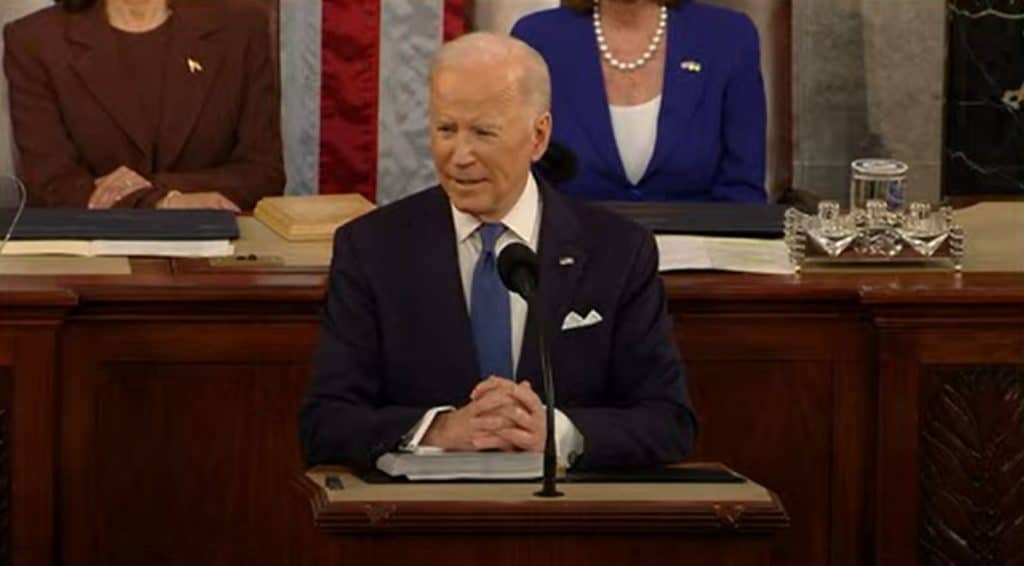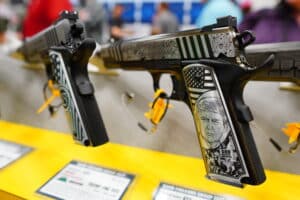Merry Christmas!
I hope you’re having a good holiday vacation surrounded by friends and family.
We have a full newsletter for you this week. Contributing Writer Jake Fogleman examines the unique way a federal judge upheld the Massachusetts “assault weapons” ban. And I explain how the leaked document detailing the Commerce Department’s plan to cut off civilian gun exports to places like Israel and Ukraine fits into the President’s domestic gun-control efforts.
Plus, The Trace’s Mike Spies joins the podcast for a candid discussion about gun suicide.

Analysis: A New Twist on the ‘Dangerous and Unusual’ Standard for Gun Bans [Member Exclusive]
By Jake Fogleman
A Massachusetts federal judge upheld the commonwealth’s ban on AR-15s and similar rifles this week. His rationale for doing so relied on an idiosyncratic understanding of the rifle’s purported lethality and defensive utility.
On Thursday, U.S. District Judge F. Dennis Saylor IV denied a motion for preliminary injunction against Massachusetts’ ban on “assault weapons” and ammunition magazines capable of holding more than ten rounds. He did so by putting a new twist on an old argument. He determined that modern laws banning AR-15s fit within the country’s historical tradition of regulating “dangerous and unusual” weapons.
“The banned weapons are ‘dangerous,’ because they are unreasonably dangerous for ordinary purposes of self-defense due to their extreme lethality and high potential for collateral harm,” Saylor, a George W. Bush appointee, wrote in Capen v. Campbell, “and they are ‘unusual,’ because it would be unusual for an ordinary citizen to carry such a weapon on his person on the street for self-defense, or to use it in the home to confront invaders or to protect against personal violence.”
While Saylor is certainly not the first to uphold a hardware ban since the Supreme Court’s Bruen decision, his analytical framework for doing so stands out among the rest for its emphasis on the “dangerous and unusual” standard and his understanding of how AR-15s fit in.
Most other judges to date have upheld such bans on the grounds that AR-15s are either not “in common use” for self-defense because of their purported lack of prevalence among spotty statistical records of defensive gun uses or because prohibitions against them fit within a tradition of regulating weapons based on “dramatic technological change and unprecedented societal concerns for public safety.”
In its 2008 District of Columbia v. Heller decision, the Supreme Court set a new floor for hardware bans when it invalidated a total ban on handgun ownership inside the home. In doing so, the Court ruled that the Second Amendment protects arms “typically possessed by law-abiding citizens for lawful purposes.” The Court further clarified the scope of this protection by drawing on the 1939 decision in United States v. Miller, stating, “Miller’s holding that the sorts of weapons protected are those ‘in common use at the time’ finds support in the historical tradition of prohibiting the carrying of dangerous and unusual weapons.”
Subsequent courts have since reviewed legal challenges to bans on certain weapons, most often AR-15s, with this limited guidance from the High Court in mind. In Saylor’s reading of the standard, AR-15s fit the bill because they are “functionally identical” to military M-16s and M-4s–despite only being capable of semi-automatic fire.
“In short, the AR-15 is a weapon with the same basic characteristics, functionality, capabilities, and potential for injury as the standard-issue rifle for infantry troops,” he wrote. “It can be fired in the same way that military forces recommend that it be used for maximum effectiveness.”
However, he noted that the rifle’s similarities to its military-issued counterpart were alone insufficient to prove that it is “dangerous and unusual,” as some other courts have found. Instead, he argued that its “military usefulness” renders it “unreasonably dangerous” compared with other civilian self-defense weapons currently recognized under Second Amendment caselaw, namely handguns.
“Rather, it is the fact that the design and features of an AR-15, compared to a typical handgun, makes it an unreasonably dangerous and unusual weapon for ordinary self-defense purposes,” he wrote. “First, the intrinsic characteristics of assault weapons make them poor self-defense weapons. AR-15s are physically unsuited to typical self-defense scenarios. They are significantly heavier and longer than typical handguns, making them less concealable, more difficult to use, and less readily accessible, particularly for an inexperienced user. They are not generally useful or appropriate weapons for ordinary citizens to keep at their bedsides or to carry on city streets as they go about their daily business.”
He also argued that the high muzzle velocity of typical AR-15 cartridges makes them “unsuitable” for self-defense and more dangerous than “ordinary 9mm handguns” due to over-penetration risks. He suggested that the rifle’s high velocity but relatively low recoil combine to make an AR-15 simultaneously more lethal than both handguns and full-powered centerfire rifles.
“Indeed, a round fired from an AR-15 distributes less than half of the kinetic energy of one fired from a hunting rifle,” he wrote. “In other weapons, the higher kinetic energy is distributed, in part, to the shooter as recoil, which necessarily disrupts follow-on shots. In an AR-15, however, the lower kinetic energy means that rounds fired with a high muzzle velocity can also be fired in rapid succession on a precise target, even while standing or moving because a shooter’s position is relatively unaffected by the recoil of each shot. Less recoil translates into ‘more rounds on target,’ and thus greater lethality.”
Saylor’s analysis of the AR-15’s dangerous and unusual nature is one gun-rights advocates will likely find fault with, but they probably won’t be the only ones. Tens of thousands of police officers in departments all across the country regularly employ AR-15s as patrol rifles for defensive purposes. Similarly, survey data indicates that approximately two-thirds of the estimated 24.6 million AR-15 owners say they own them for exactly that purpose.
Judge Saylor’s distinction between the AR-15’s purported lethality compared with higher-recoiling centerfire rifles also raises interesting legal implications for other semi-automatic long guns typically covered under assault weapon bans.
If the ability to fire low-recoiling, high-velocity intermediate cartridges is what determines if a semi-automatic weapon is “unreasonably dangerous and unusual,” does that mean full-powered semi-automatic rifle platforms like the AR-10 and SCAR 17—which typically fire the same rounds as the generic “hunting rifle” Saylor referenced—are not dangerous and therefore cannot be banned? His legal reasoning, at the very least, raises that possibility.
To be sure, the ruling is just one judge’s opinion at the District Court level. As such, its implications are fairly limited. But until the Supreme Court steps in and fully fleshes out the parameters of its Bruen test on hardware bans—which it has so far proved hesitant to do—gun owners in ban states will continue to face widely differing interpretations on the scope of their Second Amendment rights.
Podcast: A Candid Conversation on Gun Suicide With The Trace’s Mike Spies [Member Early Access]
By Stephen Gutowski
This week’s episode is a bit different than normal.
I’m speaking with Mike Spies from The Trace about his latest article. But, unlike a regular episode, this story impacts me personally. The subject of Mike’s piece was Bob Owens.
Bob was a gun-rights writer, but, more importantly, he was also a good friend of mine. Unfortunately, like many other Americans, Bob took his life several years ago.
Mike agreed to come on the podcast to talk about Bob and gun suicide. It was honestly a difficult conversation to have. But I think we were able to be frank, and I believe it was constructive.
Plus, Contributing Writer Jake Fogleman and I discuss the leaked document we published showing the Biden Admin’s plan to curtail gun exports.
You can find the show on your favorite podcasting app or by clicking here. Video of the episode is available on our YouTube channel. Reload Members get access on Sunday, as always. This week, the show will go public on Tuesday.

Analysis: Biden Continues Unilateral Push for Gun Restrictions Ahead of 2024 Election [Member Exclusive]
By Stephen Gutowski
With 2024 fast approaching, President Joe Biden is ramping up efforts to impose new gun restrictions without Congressional approval.
On Thursday, The Reload published a leaked draft of a new rule that would curtail American gun exports. That is just the latest in an increasingly long line of unilateral moves by the Biden Administration to enact gun control before the election despite the lack of new legislation. It represents a bet by President Biden that voters will reward his attempts to restrict guns.
Biden’s overall approval rating is sitting at an all-time low as he rounds the corner into the election year. He currently trails all three of the leading Republican candidates for president. He’s nearly five points behind Nikki Haley in the Real Clear Politics average of polls. The same average has him trailing Donald Trump by 2.3 points in a potential rematch despite defeating the former president just three years ago.
His performance on gun policy appears to be one factor weighing down his re-election bid. While Americans started off split on his handling of firearms, things quickly deteriorated from there. In July 2022, YouGov found his numbers had sunk. By May 2023, approval of Biden’s handling of gun policy fell to an all-time low of 31 percent in an Associated Press poll.
Those numbers seem unlikely to improve anytime soon.
Through his first term, Biden has pursued federal rulemaking to impose gun restrictions on four different occasions. He’s also defended Trump’s rule banning bump stocks all the way up to the Supreme Court. But, as the SCOTUS case probably implies, these attempts have been marred by legal troubles.
Biden’s rule that seeks to force more Americans who sell used guns to obtain a federal license is still in the public comment phase. But the gun-related rules that have made it through to official adoption up to this point have been found unconstitutional in federal court. In November, a judge blocked enforcement of Biden’s pistol-brace ban across the country. In October, a Fifth Circuit panel enjoined his “ghost gun” ban.
However, he did score something of a victory when the Supreme Court stepped in to stay that Fifth Circuit ruling. That effectively allowed the Biden Administration to continue enforcing the ban as the legal case played out. Although, it doesn’t necessarily mean the Court will side with Biden on the case’s merits.
Biden’s firearm export rule, if it does come to pass, may have an advantage over the others. Since it deals with exports instead of domestic sales, Second Amendment protections are less likely to be an impediment. The President also generally has more leeway in unilaterally determining foreign policy than domestic matters.
Of course, that doesn’t mean the rule couldn’t face the same sort of issues in clearing standards set by the Administrative Procedures Act that have tripped up the other rules. The Supreme Court has been highly skeptical of executive agencies trying to impose new policies without authorization from Congress. Changing export regulations could be problematic if done in opposition to what Congress has laid out.
Then there’s the question of how much positive impact the policy change could have, even if it does make it through the legal ringer. It suffers from the same political problem as the other initiatives.
Namely, it’s unlikely to be something that breaks through to dissatisfied gun-control advocates who want sweeping bans on AR-15s and other measures Biden can’t deliver without new legislation making it to his desk. At the same time, it’s much more likely to be noticed by gun voters, who are more likely to dislike it because it directly affects them. That’s a bad combination if the goal is to increase approval ahead of a re-election campaign.
That’s it for now.
I’ll talk to you all again soon.
Thanks,
Stephen Gutowski
Founder
The Reload







